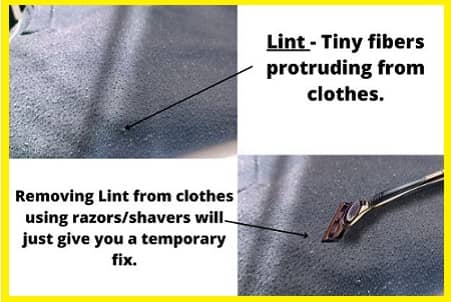Lint Filter is an important component of a washing machine, it not only filters the biodegradable material but also keeps the lint off your clothes.
With so many different types of filtering systems in washing machines, there can be many questions that come to mind.
In this post you will learn:
- What does lint mean?
- What is a lint filter?
- How to remove lint?
- And questions that are frequently asked.
Table Of Content
- What is Lint?
- What is a Lint Filter?
- Where does the lint go in a washer dryer combo?
- Do all washing machines have a lint filter?
- Can I use the washing machine without a lint filter?
- How often should you clean a washing machine filter?
- How to Remove Lint Filter?
- How to Clean Lint Filter?
- What happens when you don’t clean the lint filter?
- Why are your clothes full of lint after washing?
- Final Thoughts
What is a Lint?
Lint refers to tiny fibers that shed due to friction caused by fabrics of different types and textures during a wash cycle. These tiny fibers are generally shed from the edge of the clothes. In simple terms, these are the tiny fibers protruding from your clothes. Fabrics made up of cotton and wool are more likely to produce lint.
To add practical clarity, refer to the image below.

Does this sound familiar? 🙂
I am sure many of you may have come across instances when you had to clean the lint from the clothes using a razor or the shaver or using any other method.
What is a Lint Filter?
A Lint filter is a small pore mesh filter that collects lint in form of clothing fibers, dust particles, and other residues from the washer during a wash cycle. It is usually located on the washing tube inside the washing machine. If you are using the latest model of a High-Efficiency washer, chances are it may not have the lint trap. In fact, most modern-day laundry machines do not have an interior Lint trap.
Where does the lint go in a washer dryer combo?
A washer-dryer is a combination of a washing machine with a tumble dryer. In a washer dryer combo, the lint gets accumulated in the condenser tank during the dry cycle. A higher probability of lint accumulation is the drain pump filter area; you may need to clean this area at least once a month. Simply add a cup of vinegar with hot water and perform an empty wash cycle, this process will clean the drain pump filter and keep the minute lint accumulation away.
Note: Perform the filter clean cycle at regular intervals, in order to retain the washer’s performance in the long run.
Also Read: 11 things you should know about High-Efficiency detergents
Do all washing machines have a lint filter?
Modern Hi-Efficiency washers have in-built self-cleaning pump filters, hence they do not rely on lint filters. Lint filters are applicable mostly for the top loaders and the older versions of washers.
Can I use the washing machine without a lint filter?
If your washer has a lint filter, then technically it’s not recommended to use your washer without it being attached. If you detach the lint filter from your washer, it will reduce the washer’s efficiency and may lead to severe damage.
This is because the lint and loose fibers will get entangled with your laundry machine resulting in further clogging the drain pump filter and the hose.
You will soon start noticing the formation of molds and mildew inside the washer, which will get into your clothes during the wash cycle.
These molds can further affect your health causing allergic reactions.
Hence it is of utmost importance to have a filter attached to the machine and clean them regularly.
Also Read: Is it Necessary to have a washing machine stand?
How often should you clean a washing machine filter?
Cleaning a washing machine filter is always a good practice to retain your washer’s optimum performance. If you are an average user, it is a good practice to clean the washer filter 3 to 4 times a year.
Most often, there is no need to clean the filter manually in most modern washers due to their self-cleaning capabilities. There are various reasons or situations when you may need to have a look at the filters, below are a few scenarios:
- If your washer’s drain is getting choked or when you notice a reduction in the drain flow pressure.
- If your clothes start to build up excessive fibers after frequent washes.
- If you notice the formation of mold or bacteria in the washer.
- Although modern washers have self-cleaning capabilities, still it is a good practice to regularly check the filter and the drain whenever applicable.
Also Read: 20 Things you must know about Fabric Softeners
How to Remove Lint Filter?
The process to remove the lint filter depends on the brand and the type of washer you are using.
Having said that in most cases, the lint filters are usually located under the agitators OR placed on the side of the washer drum.
To remove the lint filter you simply need to remove the cover and check for a lint trap. These can be removed by unscrewing the lint filter trap or just by a push.
If you can’t locate a lint filter try looking at the sides of the Washer Drum OR Top of the center.
In rare cases, you may be able to locate the filter near the drainage outlet.
Note: As a beginner, in order to remove the lint filter, it is recommended to refer to the user’s manual. If you can’t get the lint filter out, don’t remove it. Follow user manuals or as an alternative take a piece of advice from an expert.
Also Read: Are Washing Machine Water Proof?
How to Clean Lint Filter?
The ideal process of removing the lint from your washing machine is to run the washer on an empty cycle by adding a suitable cleaning solution OR by simply adding a cup of white vinegar with 40% capacity of the water in the wash drum. Using warm/hot water gives a better result in this process.
The acidic nature of vinegar dissolves the soap or the detergent residues and the lint from the washtubs. This method cleans lint from almost all the corners of the washtub.
With that said, let’s take a quick look at how you can clean lint filters from the front as well as the top loaders.
1. Clean Lint from Front Loaders
Front-loaders do not rely on lint filters due to their built-in self-cleaning technology which uses pump filters in the process. Anyways there are fewer chances of lint formation in front loaders because front loaders tend to be gentler on your fabrics.
To clean the lint from the front loaders, always refer to the user’s manual in order to understand the location or the placement of the filter. This will make your task easy in detaching and reattaching the filter.
2. Clean Lint from Top Loaders
To clean lint from top loaders, follow these simple steps.
- Empty the wash drum.
- You will see the agitator at the center of the wash drum. Most of the agitators are easily detachable in top loaders. Remove the agitator cover with the proper instructions followed from your washer guide.
- Inside you will see the lint trap. It is like a cylindrical tube with a handle to pull it over and there you will find the filter attached.
- Once removed with safety, sink the filter in a tub with hot water and a liquid cleaning solution for around 10 minutes. Rinse it with clean water and now you are done, isn’t it easy?
If the filter is non-removable, in this case simply use a soft cleaning brush or a toothbrush.
Gently scrub the filter thoroughly by adding a paste of the cleaning solution and rinse with hot water.
Also Read: How to Clean a Portable Washing Machine?
What happens when you don’t clean the lint filter?
If you do not clean the lint filter from time to time, it may damage your washer. The coagulation of fabric fibers and residues of detergents will increase over time. Due to this, there is a higher possibility of clogging the water drainage system which could further result in a burnt motor pump.
Heavy fabric fibers and detergent residues make it possible for the growth of “mold”, which will further lead to the possible formation of bacteria. Mold and bacteria formation can negatively impact your health by triggering skin allergies and hay fever-type symptoms such as sneezing, runny nose, and skin rash (1).
Why are your clothes full of lint after washing?
There can be numerous reasons behind this, let’s have a look at a few scenarios for excessive lint formation on your clothes.
- Your filter may have accumulated a large number of fabric fibers.
- It’s possible the washer’s drain hose is choked due to an excessive amount of lint accumulation.
- Malfunctioning agitators might be one of the causes; here you need a piece of expert advice for a better solution. (Agitators are attached at the center of the inner wash drum, which rotates and spins in the washtub.)
- Your detergent may not be suitable for your fabric type.
- Incorrect wash cycle selected against the fabric used for the desired cleaning cycle.
Also Read: Front Load VS Top Load Detergents
Final Thoughts
Clean the washtub at least once every 3 months to retain the washer’s efficiency, and to prevent lint and mold formation.
Lastly, follow the below best practices to keep lint in check.
- Always use a suitable detergent for your fabric type to protect the clothes.
- Fabrics that tend to release excessive lint should be hand-washed. If you wash lint-shredding fabrics in your washer, then a gentle wash cycle is always preferred.
- Keep the washer clean by using Vinegar and other solutions as mentioned above.
- Removing or cleaning the lint from clothes using razors, shavers, and scotch tapes are temporary fixes. Instead, try to prevent the fabrics from lint formation.
I hope this was helpful, for more information and questions related to your laundry, refer to our FAQ section.





